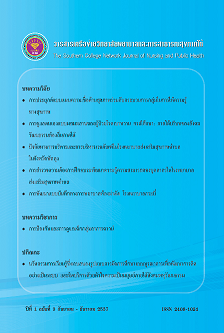การป้องกันและการดูแลเด็กกลุ่มอาการดาวน์
คำสำคัญ:
การป้องกันและการดูแล, เด็กกลุ่มอาการดาวน์, Down Syndrome, Prevention and Careบทคัดย่อ
กลุ่มอาการดาวน์ เป็นกลุ่มอาการที่เกิดจากความผิดปกติของสารพันธุกรรม พบได้ในทุกเชื้อชาติวัฒนธรรม เศรษฐานะ และภูมิประเทศ เด็กกลุ่มอาการดาวน์เกิดใหม่ปีละประมาณ 1,000 คน หรือประมาณ 3 คนต่อวัน ประมาณร้อยละ 85 ของทารกที่เป็นดาวน์ซินโดรมจะมีชีวิตรอดถึงอายุ 1 ปี และประมาณร้อยละ 50 จะมีชีวิตจนถึงอายุ 50 ปี สาเหตุของการเสียชีวิตที่สำคัญในช่วงวัยทารกและวัยเด็กมาจากความพิการของหัวใจแต่กำเนิด ปัญหาที่สำคัญของเด็กกลุ่มอาการดาวน์ที่มีรอดชีวิต คือการมีพัฒนาการช้ากว่าเด็กทั่วไป และมักพบความผิดปกติของการทำงานของระบบต่าง ๆ ในร่างกายร่วมด้วย ปัจจุบันยังไม่มีผลการศึกษาหรืองานวิจัยที่รองรับวิธีการรักษากลุ่มอาการดาวน์ในมนุษย์การศึกษาในประเทศไทยและต่างประเทศ พบว่าการกระตุ้นพัฒนาการจะช่วยเพิ่มพูนศักยภาพได้อย่างชัดเจน และจะให้ผลดีที่สุด หากทำในช่วงอายุ 2 เดือน ถึง 2 ปีแรกของชีวิต ดังนั้นเด็กกลุ่มนี้จึงควรได้รับการส่งเสริมกระตุ้นพัฒนาการโดยเร็ว เพื่อช่วยพัฒนาศักยภาพของเด็ก โดยอาศัยความร่วมมือของทุก ๆฝ่าย หากเด็กกลุ่มนี้ขาดการดูแลช่วยเหลือและไม่ได้รับการกระตุ้นพัฒนาการ จะทำให้เด็กมีปัญหาสุขภาพที่รุนแรงและซับซ้อน รวมทั้งมีพัฒนาการล่าช้า ส่งผลกระทบต่อคุณภาพชีวิตของเด็ก เพิ่มภาระแก่ครอบครัวสังคม และประเทศชาติ จึงควรป้องกันไม่ให้มีจำนวนเด็กกลุ่มอาการดาวน์เพิ่มมากขึ้น ซึ่งต้องอาศัยความร่วมมือของทุก ๆ ฝ่าย ไม่ว่าจะเป็นบุคลากรทางสาธารณสุข หน่วยงานอื่น ๆ ที่เกี่ยวข้อง รวมทั้งบิดา มารดา ผู้เลี้ยงดู และสังคมรอบข้างของเด็กกลุ่มอาการดาวน์ ซึ่งมีส่วนสำคัญที่สุดที่จะช่วยให้เด็กกลุ่มอาการดาวน์มีศักยภาพสูงสุด และสามารถดำรงชีวิตอยู่ในสังคมได้อย่างมีความสุข
Prevention and Care of Children with Down Syndrome
Down syndrome is caused by a genetic disorder which is found in every culture, race, socioeconomic status, and geography. Nearly one thousand children were born with the Down syndrome each year or about 3 cases per day. Among those children, 85 percent (%) have survived until 1 year of age. About 50 % of the 1-year survivors will live until the age of fifty years old. The major causes of death during infancy and childhood are congenital heart defects. The critical issue of Down syndrome-children who have survived is the slower development than typical children, and abnormal functioning of the various systems in the body as well. Currently, there are no studies or researches that supports the treatment of Down syndrome in human. Previous studies in Thailand and elsewhere found that the stimulation of the children who are affected by the Down syndrome is the key to enhance their potential and development.
This stimulation protocol will provide the best results if it is done in the period range where the age of the child is 2 months to 2 years of age. Therefore, the children should be encouraged by new-born stimulation protocol in order to improve their potential with the cooperation of all parties, it is to say the medical personnel, the parents, the caregivers. If the Down syndrome-child lack of good care and do not get the necessary development stimulation, he or she will have serious and complicated health problems and developmental delay. The consequences consist in a general effect over the child’s quality of life and, therefore, it come and add to the burden of the family, the society and the nation. Conclusion: it is crucial to prevent the incidence of Down syndrome through: a) an early diagnostic, b) the cooperation of the public health personnel, the involved organizations, the parents and the caregivers. Prevention is crucial in regards of the social impacts of Down syndrome among children in Thailand. Many children with Down syndrome can live happily in society.
ดาวน์โหลด
เผยแพร่แล้ว
ฉบับ
ประเภทบทความ
สัญญาอนุญาต
1. บทความหรือข้อคิดเห็นใด ๆ ที่ปรากฏในวารสารเครือข่าย วิทยาลัยพยาบาลและการสาธารณสุขภาคใต้ ที่เป็นวรรณกรรมของผู้เขียน บรรณาธิการหรือเครือข่ายวิทยาลัยพยาบาลและวิทยาลัยการสาธารณสุขภาคใต้ ไม่จำเป็นต้องเห็นด้วย
2. บทความที่ได้รับการตีพิมพ์ถือเป็นลิขสิทธิ์ของ วารสารเครือข่ายวิทยาลัยพยาบาลและการสาธารณสุขภาคใต้








